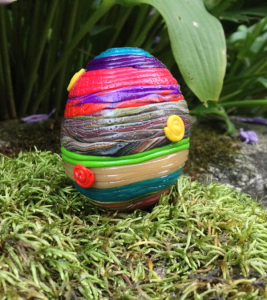Just using left over cane for a spiral eye, and half an egg that had been covered in translucent polymer clay from a previous project I made this halloween cat perched upon a half dome of spooky eyes.

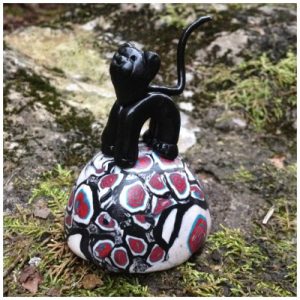
Category: Custom decorated eggs
custom decorated keepsake eggs which are made with names, and logos, custom words, to commemorate people and events
Bones (skull) egg: fun for halloween
This silly skull egg was made with a fluorescent powder (recommended by Ginger in blue bottle tree) and translucent polymer clay. I kneaded in as much as I thought I could get away with, and the clay felt a little chalky.
Apparently I needed more. It does glow a little in a dark room, but not enough to get a picture on my phone. So here are two sunny views of the three toothed cranium and mandible.. ha ha… all made over an egg.
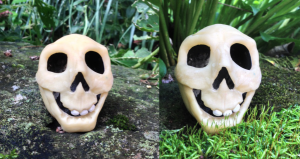
First basic layer was made (leaving eye and nose and mouth without polymer clay, and after the first curing, i just chipped out the eggshell in tho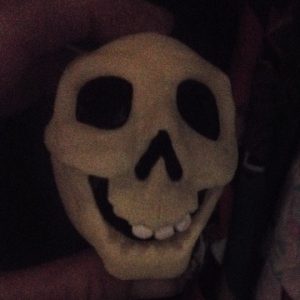 se areas, and sanded around and chipped some more. I then added the mandible and ridges over the eyes and zygoma and figured in where the teeth should go, and cured it again. Lastly, I added the three teeth (the hardest part, ha ha), cured again, and painted with black and brown acrylic paint the inside of the head. I thought about using pencil or ink to mark in the cranial sutures and foramina… ha ha. I am not totally sure why this guy looks so smiley for a skull.
se areas, and sanded around and chipped some more. I then added the mandible and ridges over the eyes and zygoma and figured in where the teeth should go, and cured it again. Lastly, I added the three teeth (the hardest part, ha ha), cured again, and painted with black and brown acrylic paint the inside of the head. I thought about using pencil or ink to mark in the cranial sutures and foramina… ha ha. I am not totally sure why this guy looks so smiley for a skull.
Crazy compound eyes: chicken egg and polymer clay sculpture
These past 8 days have seen two cataract surgeries. In one sense awesome, and in another, disappointing just because man has not accomplished what nature has accomplished (beginning with the first photosensitive cells, developing quickly in the Cambrian Explosion period some 550 million years ago). I felt obliged to create something with polymer clay to remind me of the event, and show that I am grateful for the improved vision, yet know that what was lost was far more complex in design (yes, it had gone awry from occupational and environmental impact) than the lens that replaced it.
So here is an eyeball sculpture I call “ode to cataract surgery”. Notice the little metal shield that I used as the compound eyeball – stand, was a leftover part of the recovery routine to protect the position of my new lens during sleep.

Early on, eyes were just eye spots, then photo-cups, later developing into pin-hole cameras, then cameras with optical chambers and mechanisms for focus. Check out the wonderful wikipedia link HERE. What an astonishing range of adaptations emerged during evolution for the detection of reflective bodies in a range of wavelengths, for discrimination of various high and low light intensities, monitoring object motion and permitting real time adjustment in resolution. In most vertebrates the upside down and backwards evolution allowed for pigment cells to protect the rods and cones, an arrangement not present in many other eye types. And with this….I give you a magnificent quote ….“if numerous gradations from a simple and imperfect eye to one complex and perfect can be shown to exist, each grade being useful to its possessor, as is certainly the case; if further, the eye ever varies and the variations be inherited, as is likewise certainly the case and if such variations should be useful to any animal under changing conditions of life, then the difficulty of believing that a perfect and complex eye could be formed by natural selection, though insuperable by our imagination, should not be considered as subversive of the theory” (Charles Darwin). I love it, even though it is a very run-on sentence (ha ha) it is right on point.
Here are a couple other views of the various crazy eye canes I made with polymer clay to create an compound eyeball sculpture over an emptied, and mostly round chicken egg. Just fun. Yes, I think I will give it to my eye surgeon… who was also awesome, I wonder if he will laugh.
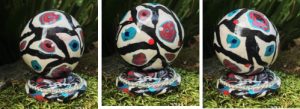
Topiary egg: polymer clay, egg shell, flowers.
This topiary egg was made with an empty chicken egg shell, which was covered first in a pale pink polymer clay and cured. Thereafter it was cut in a jagged way to simulate the cracking of a chicken egg. The halfs were covered with polymer clay canes (kind of a spiral) and cured again, and sanded. The center tree and flowers were constructed and affixed with liquid polymer clay and regular polymer clay to the bottom of the large portion of the egg shell and cured again.

Alien egg: a study in armature with polymer clay
This egg was just so fun to make, and I learned some things (which I always do when experimenting with polymer clay). I used two types of armature in the spines in the egg, which is sort of like an alien sea urchin, metal and wood. The obvious wooden armature is the small dowel of wood, one end of which I sharpened and the other was a bent wire. A third curly blue strand has no armature, but is also quite thin, and it did not slump under its own weight during three curing processes.

Step one was to cover an emptied chicken egg with translucent polymer clay (color probably doesn’t matter), a very thin layer, and before curing I carved an equator. After curing it was easy to just poke through the shell at the equator so I didn’t have to use my dremel (which makes a horribly dusty cutting event). This leads me to believe that if I can create other shapes in this same way, not just half-an-egg shapes. I covered the half and created a “flat bottom” for the egg and drilled, by hand, a about a dozen holes (which i retrospect I would drill at a later point were I to do this again. I cured the egg again, and added the rounded spots and made the spikes and curves and cured them each separately. I trimmed about 1/8 to 1/4 inch of clay, exposing each armature, at the base.
Lastly I assembled the spikes and curls by pushing the exposed armature at the end of each into the holes I had drilled, using just a little bit of liquid polymer clay to insure a bond. I cured the egg again, and then added the balls at the ends of the spikes and curls (not the tiny blue one, as it would certainly have slumped under the weight. The balls were made with polymer clay and some yellow powder that causes the clay to fluoresce after exposure to sunlight.
Then lots of Varathane to cover.. ha ha.
Polymer clay egg box and pearls
This polymer clay egg box was made using left over clay (marbelized) smoothed with a brayer over a wooden egg (dusted with baking soda as a release). I carved an equatorial cut in the coating of polymer clay just before curing. When the top and bottoms were separated with a knife, the flowers and leaves and beads were added. I actually preferred, after this experiment, using whole eggs, not wooden eggs, as separating the wooden base from the cured clay wasn’t easy.

Left-over clay and canes polymer clay egg
I really had not made a polymer clay cane until this year. I didn’t fully comprehend the amount of clay that could be used to make the very detailed canes that are found commercially. I saw an image online and about fainted – this older gentleman (I think it was a photo from somewhere in Germany) had more clay rolled into a cane than I could probably have lifted. It was an enormous, several foot long, and several inches in diameter log. Purchasing clay from some retail store it would have amounted to several hundred dollars in Fimo or other. An investment that would not likely be made by a kitchen-table-crafter such as myself. Anyway, this egg, which I actually kind of like, was made of the tips and ends of canes that I had left over.
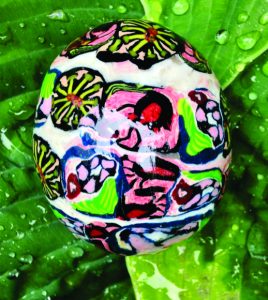
Four side cutaway egg and flowers and polymer clay
This was one of the first cut-a-way eggs I made: first a base coat of peach colored polymer clay rolled out thin, applied and then rolled smooth on the egg, and then cured. Using a dremel cutting bit I created four windows in the egg, sanded them even, then sliced up a real tiny clay pot to fit inside this gazebo type structure. I covered the egg with polymer clay cane, made borders for the four windows and decorated inside and outside with polymer clay flowers. It was exciting to figure out this technique (which while is not new in the sense of never being done before) was certainly new to me. Loving to decorate eggs in general, this was a blast.
I have listed this type of egg ornament on Memory-beads.com, as something that would be nice to do with actual flower petals (some of the clay here does have flower petals ground into it) to commemorate a special easter, or any event.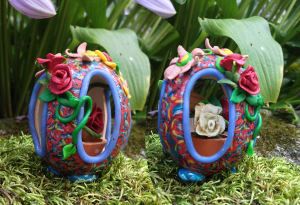
Pepsi’s flower polymer clay egg
This is a textured (and dimensional) flower egg made with a blown chicken egg and polymer clay. Two views of the same egg.

Pepsi’s polymer clay coil egg
During a visit, summer 2016, from my son and daughter-in-law and their sweet little girl Corin, we spent a lot of time playing with polymer clay. My kids and I had played with lots of Fimo, decades ago, but it was fun to resurrect that creative activity. Corin went away with many tiny objects, her dad made her the cutest sterling silver and polymer clay heart necklace and Pepsi and I made lots of polymer clay eggs. Here is one of her’s.
